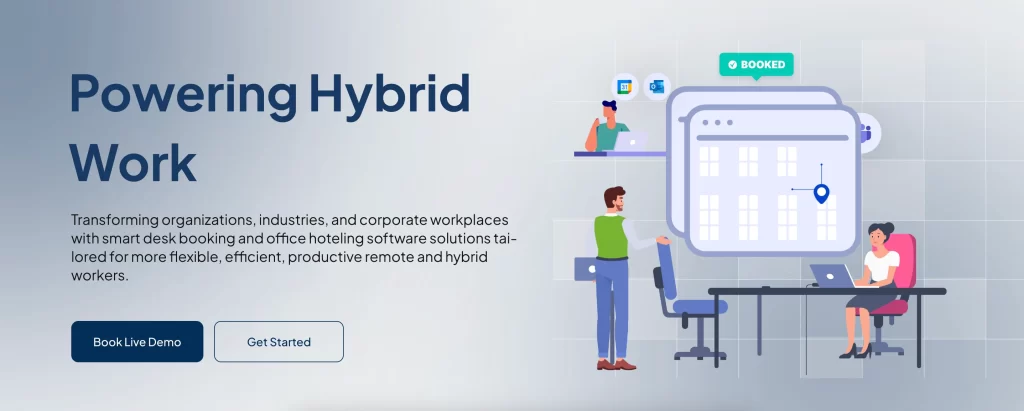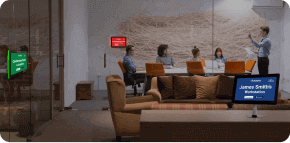
8 Tips to Maximize Workspace Efficiency
Workspace efficiency is about creating an office environment that maximizes productivity and employee satisfaction. The way an office is designed—its layout, organization, and use of space—directly impacts how effectively employees work.
Efficient workspace design benefits large companies as well as small business owners. Optimizing their office layout can improve employee engagement, productivity, and collaboration. The right setup helps reduce wasted time and keeps employees focused on their tasks.
In this article, we will explore the essential elements that make a workspace efficient and how small business owners and larger companies alike can benefit from optimizing their office environments.
Tips to Optimize Workspace Productivity
Here are some practical tips for improving workspace efficiency and creating a more productive office environment:
1. Optimize Office Layout
An efficient office layout is essential for balancing collaborative and individual work. Open spaces are ideal for teamwork, fostering collaboration and creativity among employees.
However, quiet zones or separate spaces like private rooms should be available for those working on tasks that require concentration.
Flexible layouts, like hot-desking or modular furniture, allow for easy reconfiguration of the office space depending on the day’s needs.
2. Incorporate Natural Light
Natural light plays a vital role in improving workplace efficiency. Positioning desks near windows allows employees to enjoy natural light, which can reduce eye strain and boost mood. Studies have shown that access to natural light can improve concentration and reduce fatigue.
By placing workstations where sunlight is abundant, companies can create a brighter, more energizing environment that helps keep employees focused throughout the day.
3. Declutter and Organize
A cluttered workspace can be distracting, leading to decreased productivity. Implementing organizational solutions like filing cabinets, shelves, and desk organizers helps keep the office tidy.
Encourage employees to declutter their desks daily, creating a habit of maintaining a clean workspace.
Flexible workspaces that adapt to employees’ needs can further enhance the organization. They ensure that everything has its place and reduce the time spent searching for items, allowing employees to stay focused on their work.
4. Utilize Technology for Efficiency
Technology is key to improving productivity in modern offices. Project management tools like Asana, Slack, or Microsoft Teams streamline communication and task tracking, making it easier for teams to collaborate without miscommunication.
Additionally, room booking systems can help employees quickly reserve meeting rooms and ensure there are no scheduling conflicts, eliminating the back-and-forth often associated with reserving shared spaces.
5. Provide Breakout Areas
Breakout areas are essential for giving employees a place to relax, recharge, or hold informal discussions. These spaces should be designed with comfort in mind, offering sofas, chairs, and tables where employees can take short breaks or brainstorm in a more relaxed setting.
Providing a space away from the desk can help employees clear their minds, returning to work more focused and energized, which can improve efficiency by reducing mental fatigue and encouraging creativity.
6. Promote Clean Air and Ventilation
Good air quality is crucial for a healthy, productive workspace. Poor ventilation can lead to fatigue, headaches, and difficulty concentrating. Offices should ensure proper air circulation by using air purifiers and keeping windows open when possible.
Clean air not only promotes physical health but also enhances cognitive function, helping employees stay sharp throughout the workday.
7. Facilitate Collaboration
Encouraging collaboration is key to fostering innovation and problem-solving. Common areas such as shared workspaces or meeting rooms equipped with digital tools—like interactive whiteboards—help teams share ideas in real time.
These collaborative spaces should be strategically placed within the office to encourage spontaneous interactions and discussions, boosting creativity.
8. Minimize Noise Distractions
Noise can be a significant productivity killer in busy office environments. Solutions like noise-canceling headphones or soundproofing materials can help reduce ambient noise and create a more focused work atmosphere.
Offices can also set up designated quiet zones, giving employees who need to focus a place to work without interruptions. These adjustments not only improve productivity but also contribute to a positive company culture where employees feel supported in their work environment.
Why Workplace Productivity Matters
An efficient workspace plays a significant role in both productivity and employee satisfaction. When an office is organized and thoughtfully designed, it reduces distractions and allows employees to focus better on their work.
A clutter-free environment, with clear pathways between workstations and accessible meeting rooms, ensures that employees can move around the office easily, minimizing time spent searching for the right space or resource.
Benefits of an Efficient Workspace
- Cost savings: By optimizing how office space is used, businesses can reduce the need for additional real estate. When every corner of the office is purposefully utilized, there’s less wasted space, which means companies don’t have to invest in renting or buying more square footage.
- Improved collaboration: Smart office layouts promote more employee interaction by placing teams closer together and creating open spaces for easy communication. When employees are able to interact spontaneously, whether at a central hub like a central water cooler or a coffee station, or in open meeting rooms, they can brainstorm more effectively and solve problems faster.
- Better use of resources: In an efficient workspace, resources like office tools, meeting rooms, and equipment are fully utilized. By creating systems to track and manage these resources, such as using room scheduling software, companies can ensure that office spaces are never sitting idle.
Customizing the Office Space for Different Business Needs
By customizing the office design to suit specific requirements, businesses can create a more effective and adaptable workspace.
Here’s how to approach open office layout for both small and large organizations, ensuring that key areas like conference rooms are strategically placed for meetings and collaborative sessions while maintaining separate spaces for focused work:
For Small Business Owners
Small business owners can enhance workspace efficiency by maximizing the use of limited office space while maintaining cost-effective solutions.
- In a smaller office, every inch counts. Focus on creating multifunctional spaces that can be used for different purposes. For example, a meeting room could double as a quiet workspace or a brainstorming area.
- Small businesses can save on costs by using modular furniture that adapts to changing needs. Shared workstations, hot-desking, and compact storage solutions help optimize physical space without sacrificing functionality. These flexible setups also contribute to a positive company culture by fostering collaboration and adaptability, allowing employees to work in an environment that supports both individual focus and teamwork.
For Larger Companies
Larger companies can optimize workplace efficiency by designing adaptable office layouts that accommodate various work styles and evolving business needs.
- Large offices benefit from diverse spaces that cater to different work styles. Open areas for collaboration, private meeting rooms for focused discussions, and breakout zones for relaxation all contribute to creating an efficient workplace while boosting overall productivity.
- As business needs change, the office layout should remain flexible. Movable partitions, adjustable workstations, and flexible offices with adaptable meeting rooms help larger companies adjust to evolving workflows and team sizes without major disruptions.
A hybrid work platform can further enhance the adaptability of office spaces. By integrating flexible office layouts with hybrid work tools, both small businesses and large companies can seamlessly support on-site and remote employees, fostering collaboration and productivity in any environment.
Maximize Office Space with DeskFlex

By integrating desk and room booking systems, DeskFlex ensures that every inch of your workplace is utilized efficiently, reducing wasted space and improving overall workplace productivity.
Here’s how DeskFlex achieves this:
Real-Time Desk and Room Booking
DeskFlex allows employees to reserve desks, meeting rooms, and other office resources in real time. This feature prevents double bookings and makes sure that all available spaces in flexible offices are used effectively, eliminating the issue of underutilized rooms or desks sitting empty.
Hot-Desking and Flexible Workstations
For businesses embracing hybrid work models, DeskFlex’s hot-desking feature is particularly valuable. It allows employees to book desks when they need them, ensuring that office space is only used when employees are physically present.
This flexible approach reduces the need for permanent workstations, saving space and cutting down on overhead costs.
3D Floor Maps and Space Visualization
DeskFlex’s 3D floor maps, powered by innovative technology, give a clear visual representation of the office setting, making it easy for employees and managers to see which spaces are available in real time.
This is something that boosts productivity by allowing teams to make quick decisions about room availability, space allocation, and resource usage.
Analytics and Reporting
DeskFlex offers data-driven insights into how your office space is used. The platform tracks desk usage, room occupancy, and meeting patterns, providing managers with detailed reports that help them make informed decisions about office layout and space management.
This data can be used to reallocate resources, redesign flexible offices, and improve overall employee productivity, ensuring that the workspace is optimized for efficiency and effectiveness.
By combining these features, DeskFlex maximizes private offices, helping businesses streamline operations, save on costs, and create a more efficient workspace for their employees.
Ready to make your office more efficient? Book a demo with DeskFlex today and start optimizing your workspace!
FAQs About Workspace Efficiency
What is workplace efficiency?
Workplace efficiency refers to how well an office environment is organized to support employee productivity and satisfaction. It involves creating a layout, incorporating technology, and providing resources that allow employees to complete tasks with minimal distractions, wasted time, or resources. Efficient workspaces enhance collaboration, focus, and overall performance.
What is the efficiency of the workspace?
The efficiency of a workspace is measured by how effectively physical space is utilized to maximize productivity. This includes the strategic placement of desks, meeting rooms, breakout areas, and resources like technology. By optimizing space usage, companies can minimize wasted resources, reduce overhead costs, and improve the workflow of employees.
What is an effective workspace?
An effective workspace is designed to support both collaboration and individual work, ensuring that employees have access to the tools and resources they need to perform their jobs efficiently. This includes aspects like ergonomic furniture, good air quality, natural light, and organized spaces that help reduce distractions and boost productivity.















































 Support
Support  Demo
Demo  Blog
Blog 